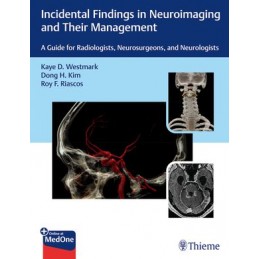- Obniżka


 Dostawa
Dostawa
Wybierz Paczkomat Inpost, Orlen Paczkę, DHL, DPD, Pocztę, email (dla ebooków). Kliknij po więcej
 Płatność
Płatność
Zapłać szybkim przelewem, kartą płatniczą lub za pobraniem. Kliknij po więcej szczegółów
 Zwroty
Zwroty
Jeżeli jesteś konsumentem możesz zwrócić towar w ciągu 14 dni*. Kliknij po więcej szczegółów
A multidisciplinary guide to managing incidental findings in neuroimaging from top experts
Incidental Findings in Neuroimaging and Their Management:: A Guide for Radiologists, Neurosurgeons, and Neurologists presents a streamlined, case-based approach to 50 commonly seen incidental findings in neuroimaging. Edited by Kaye Westmark, Dong Kim, and Roy Riascos, this unique book provides the necessary knowledge to manage significant unexpected findings—from identification and analysis to efficacious interventions. With collaborative contributions from neuroradiologists, neurosurgeons, neurologists, otolaryngologists, body and musculoskeletal imaging experts, endocrinologists and hematologists/oncologists, this resource encompasses a wide spectrum of incidental findings.
Organized by six sections, the book starts with normal variants that are extremely important to recognize in order to avoid unwarranted additional testing and unnecessary stress for the patient. Subsequent sections detail abnormalities that require extensive clinical evaluation in order to determine ideal management. These include incidental findings for extracranial, extra-spinal, intracranial, and intraspinal imaging. The final section outlines CT and MR imaging artifacts that are particularly concerning because they may mimic more dangerous pathologies while degrading imaging quality and obscuring real findings.
Key Features
This essential guide will help trainee and practicing neuroradiologists, neurosurgeons, and neurologists interpret incidental spine and brain imaging findings and make clinically informed, complex treatment decisions.
This book includes complimentary access to a digital copy on https://medone.thieme.com.
Opis
Section I Normal Variants
1. Persistent Primitive Trigeminal Artery
2. Arachnoid Granulations
3. Asymmetry of the Lateral Ventricles
4. Basal Ganglia/Dentate Nuclei Mineralization
5. Cavum Septum Pellucidum
6. Choroid Fissure Cyst
7. Empty Sella Configuration
8. High-Riding Jugular Bulb
9. Hyperostosis Frontalis Interna
10. Prominent Perivascular Space
11. Simple Pineal Cyst
Section II Intracranial Incidental Findings
12. Diffuse White Matter Hyperintensities
13. Brain Capillary Telangiectasias
14. Developmental Venous Anomaly
15. Cerebral Cavernous Malformations
16. Colloid Cyst
17. Arachnoid Cysts
18. Mega Cisterna Magna
19. Benign Enlargement of Subarachnoid Spaces
20. Pituitary Incidentaloma and Incidental Silent Macroadenoma
21. Pituitary Gland: Diffuse Enlargement
22. Incidental Glial Neoplasms
23. Incidental Meningioma
Section III Head and Neck-Associated Incidental Findings
24. Head and Neck-Related Incidental Findings
Section IV Spinal Incidental Findings
25. Os Odontoideum
26. Tarlovs Cyst
27. Approach to the Solitary Vertebral Lesion on Magnetic Resonance Imaging
28. Diffusely Abnormal Marrow Signal within the Vertebrae on MRI
29. Filum Terminale Lipoma
30. Ventriculus Terminalis
31. Prominent Central Canal
32. Low-Lying Conus
33. Incidental Solitary Sclerotic Bone Lesion
Section V Extraspinal Incidental Findings
34. Abdominal Aortic Aneurysm
35. Renal Mass
36. Renal Cyst
37. Thyroid Mass
38. Adrenal Mass
39. Retroperitoneal Lymph Nodes
40. Incidental Pelvic Mass
Section VI Artifacts That May Obscure Pathology and Simulate Disease Entities
41. Computed Tomography Artifacts
42. MRI Patient-Related Motion Artifacts
43. Magnetic Susceptibility-Related Artifacts on MRI
44. MRI Technical and Sequence-Specific Artifacts
